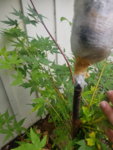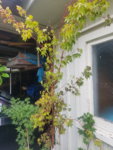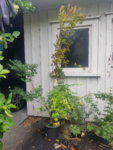I too am somewhat confused about the current status of this, but it is an all-to-familiar a story to me. The bottom line is that
even if only some leaves on the layer have withered, turned brown and are still hanging on, there is no hope for the layer.
If you were watching daily.
@Cuzza, you would have seen this withering & browning move progressively up the branch being layered. As disappointing as it is, I am still a fascinated watching this, when it happens. On the plus side of these catastrophes, I learned more about basic tree physiology from them than just about anything else I've done.
Auxin is produced by branch tips, buds (new branch tips located at nodes), and leaves. Some gets loaded into the phloem (inner bark) along with carbohydrates from photosynthesis, but it is biologically inactive. The biologically active auxin is handed off from one cambium cell to the next by some special proteins (PIN). As a consequence, this biologically active auxin moves in only one direction, toward the roots, by a process that is known as Polar Auxin Transport (PAT).
In a sense, PAT serves as a signal that there is life above. When we prune or girdle a branch, we disrupt PAT to the cambium cells at the top of the cut or bottom of the girdle. The cambium doesn't die immediately because some can be unloaded from the phloem. Stuff in the phloem can go up or down, equally, but to go up it must overcome gravity. It can, because the phloem is pressurized by the cells in the leaves that actively load carbohydrates and auxin into the phloem tubes. So the cambium continues to live until the topmost cells can no longer off load enough auxin. Then they die and the next in line following the direction of the PAT stream. As this happens, the bark on acer palmatums turns to dark brown or black. The blackening will usually stop at the next node below because nodes have auxin sources = buds (though they may not be visible).
I think you can see this from this photograph. Dry withered leaves still clinging to the layered branch can be seen in the lower right corner. Moving left (which is downward, toward the roots of the mother tree), the green stem of the layer, the few roots that had formed, the girdle. and the blackening stem below (in the sense of PAT). The blackening has extended downward, almost to the node below which has a thin live branch. Given a little more time, the blackening would have stopped at this node.

If the stem had been pruned at the same point instead of it being girdled, exactly the same thing happens to the bark of the 'stub'.
I find a discoloration in the wood that extends above the girdle and is generally off-set upward relative to the bark necrosis that reflects the xylem being plugged as part of the response to the cambium apoptosis (i.e., the signalling substance is carried in the xylem sap flow). I can only find this photo of the cross-section below the girdle that shows the discoloration in the wood. Maybe you can make a similar longitudinal section that does extend above the girdle and photograph it for us,
@Cuzza (that is, if I am describing what has happened to your Sangokaku). I am quite certain you will find that the clogged-xylem discoloration extends well above the girdle.

I likely have said in the past that this comes from ethylene signalling and I think that is not correct (
@cbroad). Ethylene signalling is, however, responsible for leaf coloring and abscission.
Often we apply some rooting hormone to the upper edge of the girdle to 'kick start' the rooting process. IBA overdoses can cause dramatic coloration of the leaves above. I've dusted girdles with as much as 4.5% IBA and made acer palmatum and stewartia pseducamellia leaves dramatically turn brilliant red. We can make layers without any exogenous (from outside, applied by me, you) auxin. Because of PAT, auxin piles up at the top of the girdle. This accumulation causes the stem to swell there - an ethylene response. Hence, as
@cbroad said,
Discoloration of the foliage is normal for air layers
So, what do we do about it? It is a question that I have been asking myself for a number of years because this sort of 'flame out' has happened to every layer I've attempted on my acer palmatum 'Higasayama'. Multlple attempts almost every season for close to 10 years now. Evidently, what one must do is leave a small/narrow bridge across the girdle; just enough to maintain the PAT. Too wide a bridge and the auxin is drained away from above the girdle, so that we no longer will have the high level of auxin needed to make roots grow. I got close with Higasayama this past season (the narrow bridge got to wide). It is such a blindingly obvious thing to do, but my prior experience was that layers failed (not catastrophically, just no roots) when there was any hint of 'bridging'. I tried applying auxin pastes at the bottom of the girdle, longitudinal cuts painted with IBA liquids, and carving 'windows' in the bark instead of a complete girdle that didn't work. Any bridge across a girdle will inevitably widen, so I/we must expose and renarrow it a few times during the season (of course, taking great care not to damage the nascent roots). I have yet to think of a way to avoid this.
... gawd, it is almost Friday already. I run on ...





